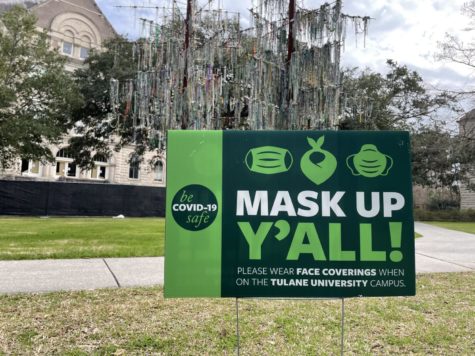Tulane prepares for COVID-19 successful Mardi Gras
February 16, 2022
With Carnival season finally upon New Orleans, the waning but still-present threat of COVID-19 has Tulane University preparing for this year’s Mardi Gras with optimism and caution.
After the disruptions COVID-19 imposed on Mardi Gras celebrations in 2021, this year’s Carnival season was long and eagerly awaited. Many Tulanians remain enthusiastic to once again, or for the first time, engage in its parades and festivities.

Despite the recent COVID-19 case spikes following the rise of the omicron variant, the university remains hopeful that its COVID-19 protocols will allow students to safely participate in and enjoy Mardi Gras.
As of Feb. 8, the spring 2022 COVID-19 protocols established by Tulane Campus Health require that all individuals, regardless of vaccine status, wear a mask while indoors.
Tulane’s in-place surveillance testing program also requires that any faculty, staff, undergraduate, graduate and professional student randomly selected for testing comply, regardless of vaccination status.
These protocols will remain in place prior to, during and after Mardi Gras, according to Alicia Czachowski, director of public health initiative and assessment.
“This will help to monitor any increases in the community during the Mardi Gras period,” she said.
In anticipation of the heightened positivity rates that may ensue, Erica Woodley, associate vice president and dean of students, said that the university has plans for limited off-campus isolation space to be available during and immediately after Mardi Gras.
“However,” Woodley said in a written statement, “given the rates of positivity in our community at the end of the semester in the fall, over the break and at the beginning of the spring semester, we are hopeful that we will not see a significant surge.”
The ongoing presence of COVID-19 in the Tulane community over the last two years has prepared Campus Health to handle the potential impact of Mardi Gras on the university’s COVID-19 case numbers.
“Tulane has had to manage multiple spikes in COVID – return after Thanksgiving and return after winter break – that have helped to prepare us to future surges and what to expect,“ Czachowski said.
Despite that preparation, Czachowski said, “it is difficult to project a specific scenario because, as we have seen over the course of the pandemic, it has been un-predictable.”
To keep the community safe while participating in Mardi Gras, Campus Health advised students to keep up with their vaccinations, continue to wear masks at both indoor and outdoor events, closely monitor their symptoms and comply with the random testing protocols when notified.
“At many of the Mardi Gras educational and social events, Tulane will be making hand sanitizers and masks available to community members as well,” Czachowski said.
Alongside the efforts to prepare for the potential COVID-19 related implications of Mardi Gras, student safety during Carnival season remains a priority for the university.
“We are always concerned about safety during Mardi Gras as the population of the city expands significantly,” Woodley said.
“We encourage students to make use of the university shuttles that will be transporting students to and from the parade route,” she said.
“We encourage our students to travel in pairs, even if in large groups, to make sure that your cell phone is fully charged (bring a battery back-up if you have one) and don’t accept drinks (alcoholic or non-alcoholic) from anyone you don’t know and trust,” Woodley said.









Chris Arteberry • Feb 22, 2022 at 11:09 am
We need to get pat the mask up everyone indoors narrative. New evidence shows masks protect the wearer even when others remain mask free. An individual wearer is protected regardless of whether others wear a face covering- ~17-20% with cloth masks, 50% with surgical masks, and 80-90% with N95. It is now clearly a personal choice, especially in light of the far milder Omicron variant! Per the Lancet early this month-“the percent of asymptomatic cases is between 80-90% for Omicron.”